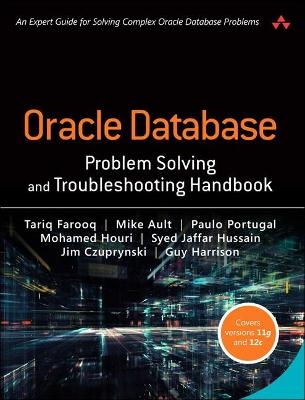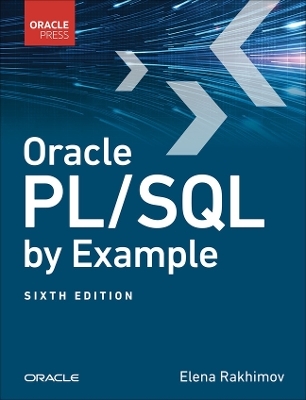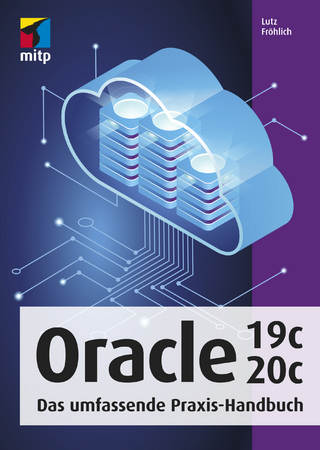
Oracle Database Problem Solving and Troubleshooting Handbook
Addison Wesley (Verlag)
978-0-13-442920-5 (ISBN)
Oracle Database Problem Solving and Troubleshooting Handbook delivers comprehensive, practical, and up-to-date advice for running the Oracle Database reliably and efficiently in complex production environments. Seven leading Oracle experts have brought together an unmatched collection of proven solutions, hands-on examples, and step-by-step tips for Oracle Database 12c, 11g, and other recent versions of Oracle Database. Every solution is crafted to help experienced Oracle DBAs and DMAs understand and fix serious problems as rapidly as possible.
The authors cover LOB segments, UNDO tablespaces, high GC buffer wait events, poor query response times, latch contention, indexing, XA distributed transactions, RMAN backup/recovery, and much more. They also offer in-depth coverage of a wide range of topics, including DDL optimization, VLDB tuning, database forensics, adaptive cursor sharing, data pumps, data migration, SSDs, indexes, and how to go about fixing Oracle RAC problems.
Learn how to
Choose the quickest path to solve high-impact problems
Use modern best practices to make your day more efficient and predictable
Construct your “Call 9-1-1 plan” for future database emergencies
Proactively perform maintenance to improve your environment’s stability
Save time with industry-standard tools and scripts
Register your product at informit.com/register for convenient access to downloads, updates, and corrections as they become available.
Tariq Farooq is an Oracle technologist, architect, and problem-solver and has been working with various Oracle Technologies for more than twenty-four years in very complex environments at some of the world’s largest organizations. Having presented at almost every major Oracle conference/event all over the world, Tariq is an award-winning speaker, community leader/organizer, author, forum contributor, and tech blogger. He is the founding president of the IOUG Virtualization & Cloud Computing Special Interest Group and the BrainSurface social network for the various Oracle communities. Tariq founded, organized, and chaired various Oracle conferences, including, among others, the OTN Middle East and North Africa (MENA) Tour, VirtaThon—the largest online-only conference for the various Oracle domains, the CloudaThon & RACaThon series of conferences, and the first-ever Oracle-centric conference at the Massachusetts Institute of Technology (MIT) in 2011. He was the founder and anchor/show host of the VirtaThon Internet Radio series program. Tariq is an Oracle RAC Certified Expert and holds a total of 14 professional Oracle certifications. Having authored more than one-hundred articles, whitepapers, and other publications, Tariq is the coauthor of the Expert Oracle RAC 12c (Apress, 2013), Oracle Exadata Expert’s Handbook (Addison-Wesley, 2015), and Building Database Clouds in Oracle 12c (Addison-Wesley, 2016) Oracle books. Tariq has been awarded the Oracle ACE and ACE Director awards. Mike Ault began working with computers in 1980—following a six-year Navy enlistment in the Nuclear Navy riding submarines—programming in Basic and Fortran IV on the PDP-11 architecture in the nuclear industry. During Mike’s nuclear years he worked with PDP, IBM-PC, Osborne, and later VAX-VMS and HP architectures, as well as with the Informix and Ingres databases. Following the downturn in the nuclear industry, Mike began working with Oracle as the only DBA at the Luka, Mississippi–based Advanced Solid Rocket Motor (ASRM) project for NASA in 1990. Since 1990, Mike has worked with a variety of industries using Oracle both in-house and as a consulting talent. Mike got extensive Flash experience as the Oracle Guru for Texas Memory Systems. Mike transitioned to IBM as the Oracle Guru for the STG Flash group when IBM purchased TMS in 2012. Mike has published over two dozen Oracle-related books, including the 7.0, 8.0, 8i and 9i versions of his Oracle Administration and Management with Wiley, the “Oracle8 Black Book” and “Oracle DBA OCP Exam Cram” series (for versions 8 and 8i) with Coriolis, and multiple titles including Oracle9i RAC and Oracle10g Grid & Real ApplicationClusters with Rampant Technical Press. Mike has written articles for Oracle, Select, DBMS, Oracle Internals, and several other database-related magazines. Mike is also a highly sought-after keynote speaker and expert instructor for local, regional, and international Oracle conferences, such as GOUSERS, SEOUG, RMOUG, NYOUG, NCOUG, IOUG, OOW, ODTUG, UKOUG, and EOUG. Paulo Portugal has more than fifteen years of IT experience as an Oracle DBA. He is an Oracle Certified Master 11g; an Oracle Certified Professional (9i, 10g, 11g, and 12c); an Oracle RAC 10g and 11g Certified Specialist; an Oracle DBA 10g Certified Linux Administrator; Oracle Exadata Implementation Certified; IBM DB2 Certified (8 and 9 “Viper”); an Oracle GoldenGate 10 Certified Implementation Specialist; an Oracle Enterprise Manager Certified Implementation Specialist; and an Oracle 11i Applications Database Administrator Certified Professional. Paulo is the author of the Rampant “Advanced DBMS Packages” and many articles in blogs and some magazines and websites. Paulo has maintained a regular presence on the Oracle conference and speaking circuit: Oracle Open World—San Francisco (2005, 2006, 2011, and 2013); IBM Information on Demand—Los Angeles (2006); Burleson Oracle RAC Cruise (2009); and Oracle Training in Reading—United Kingdom (2011). Currently, Paulo works as an Oracle sales consultant for Oracle Brazil. Paulo has participated in the Oracle Beta Test 11i project using Data Guard and is a specialist in high Availability tools such as Oracle Data Guard, Oracle Streams, Oracle GoldenGate, and Oracle RAC. Mohamed Houri has a Ph.D. in fluid mechanics (scientific computing) from the University of Aix–Marseille II, preceded by an engineer diploma in aeronautics. He has been working around the Oracle database for more than fourteen years for different European customers as an independent Oracle consultant specializing in tuning and troubleshooting Oracle performance problems. Mohamed has also worked with the Naval Architect Society of Japan on the analysis of tsunamis and breaking waves using a powerful signal analysis called Wavelet Transform. He maintains an Oracle blog and is active in the Oracle Worldwide forum and in the French equivalent. He tweets about Oracle topics at @MohamedHouri. Syed Jaffar Hussain is an Oracle Database expert with more than twenty years of IT experience. For more than a year, he has been involved with several local and large-scale international banks where he implements and manages highly complex cluster and Exadata environments with hundreds of business-critical databases. Oracle awarded him the prestigious Best DBA of the Year and Oracle ACE Director status in 2011. He also acquired industry-best Oracle credentials, Oracle Certified Master (OCM), Oracle RAC Expert, OCP DBA 8i, 9i, 10g, and 11g, in addition to ITIL expertise. Syed is an active Oracle speaker who regularly presents technical sessions and webinars at many Oracle events. You can visit his technical blog at http://jaffardba.blogspot.com. In addition to being part of the core technical review committee for Oracle technology–oriented books, he coauthored Oracle 11g R1/R2 Real Application Clusters Essentials (Packt Publishing, 2011), Expert Oracle RAC 12c (Apress, 2013), and Oracle Exadata Expert’s Handbook (Addison-Wesley, 2015). Jim Czuprynski is an Oracle ACE Director with more than thirty-five years of experience in information technology, serving diverse roles at several Fortune 1000 companies in those three-plus decades—mainframe programmer, applications developer, business analyst, and project manager—before becoming an Oracle DBA in 2001. In his current role as a strategic solutions consultant for OnX Enterprise Solutions, he focuses on providing his expertise to help customers understand how to best leverage Oracle technology to solve their most difficult IT challenges. As a senior Oracle University instructor, Jim has taught Oracle core technologies, Exadata, and GoldenGate to more than two-thousand Oracle DBAs since 2005. He was selected as Oracle Education Partner Instructor of the Year in 2009. Jim’s most recent book, Oracle Database Upgrade, Migration & Transformation Tips & Techniques (McGraw-Hill Education, 2015), takes a nitty-gritty approach to tackling the best ways to migrate, transform, and upgrade Oracle databases to 12c, Exadata, and beyond. Jim continues to write a steady stream of articles that focus on the myriad facets of Oracle database administration, with more than one-hundred articles to his credit since 2003 at databasejournal.com and ioug.org. Jim’s blog, Generally . . . It Depends, contains his regular observations on all things Oracle. Jim is also a sought-after public speaker on Oracle Database technology features. Since 2008, he has presented topics at Oracle OpenWorld, IOUG’s COLLABORATE, Hotsos Symposium, Oracle Technology Network ACE Tours, and Oracle User Group conferences around the world. Guy Harrison is an executive director of research and development at Dell Software, where he oversees the development of database tools such as Toad and Shareplex. Guy is the author of six books on database technology, including Next Generation Databases (Apress, 2015), O racle Performance Survival Guide (Prentice Hall, 2010), and MySQL Stored Procedure Programming (O’Reilly, 2006). He also writes the “Big Data notes” column for Database Trends and Applications (dbta.com). Guy can be found on the Internet at www.guyharrison.net, and at @guyharrison on Twitter.
Preface xix
Acknowledgments xxi
About the Authors xxv
About the Technical Reviewers and Contributors xxix
Chapter 1: Troubleshooting and Tuning LOB Segment Performance 1
Introduction to the LOB Datatype 1
BASICFILE versus SECUREFILE LOBs 8
The Impact of PCTFREE on LOBs 14
Overcoming Poor INSERT Performance 17
Summary 17
Chapter 2: Overcoming Undo Tablespace Corruption 19
Overview of Undo Management 19
DTP, XA, and Rollback Segments 22
Recovering from Undo Tablespace Corruption 24
Summary 32
Chapter 3: Handling GC Buffer Busy Wait Events 35
Overview of Buffer Busy Wait Events 35
Leveraging the ORAchk Utility 36
Isolating GC Buffer Busy Waits 40
Isolating GC Buffer Busy Wait Event Issues 45
Fixes for GC Buffer Busy Waits 49
Summary 50
Chapter 4: Adaptive Cursor Sharing 51
ACS Working Algorithm 52
ACS in Action 58
ACS Bind-Awareness Monitoring 61
The Bind-Aware Cursor 73
A Practical Case 76
Summary 81
Chapter 5: Stabilizing Query Response Time Using SQL Plan Management 83
Getting Started 83
Creating a SQL Plan Baseline 87
Faking Baselines 92
Oracle Optimizer and SPM Interaction 96
SQL Plan Baseline Reproducibility 108
NLS_SORT and SQL Plan Baseline Reproducibility 114
ALL_ROWS versus FIRST_ROWS 117
Adaptive Cursor Sharing and SPM 122
Summary 131
Chapter 6: DDL Optimization Tips, Techniques, and Tricks 133
DLL Optimization Concept 133
The DDL Optimization Mechanism 136
DDL Optimization for NULL Columns 147
Summary 152
Chapter 7: Managing, Optimizing, and Tuning VLDBs 153
Overview of Very Large Databases 153
Optimal Basic Confi guration 154
VLDB Performance Tuning Principles 162
Gathering Optimizer Statistics 166
Backup and Recovery Best Practices 170
Summary 172
Chapter 8: Best Practices for Backup and Recovery with Recovery Manager 173
A Perfect Backup and Recovery Plan 173
An Overview of RMAN 174
Tips for Database Backup Strategies 175
Validating RMAN Backups 186
Backup Optimization and Tuning 187
Using RMAN for RAC Databases 189
Retaining Data in a Recovery Catalog 191
Having a Robust Recovery Strategy 192
Leveraging the Data Recovery Advisor 193
Summary 194
Chapter 9: Database Forensics and Tuning Using AWR Analysis: Part I 197
What Is AWR? 197
Knowing What to Look For 199
Header Section 199
RAC-Specific Pages 208
Time Model Statistics 211
Operating System Statistics 212
The SQL Sections 217
Instance Activity Statistics 221
Summary 233
Chapter 10: Database Forensics and Tuning Using AWR Analysis: Part II 235
Tablespace I/O Statistics 235
Buffer Pool Statistics 237
PGA Statistics 240
Shared Pool Statistics 244
Other Advisories 245
Buffer Waits Statistics 247
Enqueue Statistics 248
Undo Segment Statistics 250
Latch Statistics 251
Segment Access Areas 255
Library Cache Activity Sections 257
Dynamic Memory Components Sections 260
Process Memory Sections 262
Streams Component Sections 264
Resource Limits Statistics 266
Initialization Parameter Changes 267
Global Enqueue and Other RAC Sections 268
Summary 273
Chapter 11: Troubleshooting Problematic Scenarios in RAC 275
Troubleshooting and Tuning RAC 276
A Well-Oiled RAC Ecosystem 279
Troubleshooting RAC with OEM 12c 282
Utilities and Commands for Troubleshooting 283
Summary 288
Chapter 12: Leveraging SQL Advisors to Analyze and Fix SQL Problems 289
OEM 12c—SQL Advisors Home 290
SQL Tuning Advisor 290
SQL Access Advisor 295
SQL Repair Advisor 300
SQL Performance Analyzer 301
Summary 302
Chapter 13: Extending Data Pump for Data and Object Migration 303
Using Data Pump 303
Working with Private and Public Objects 306
Finding Valid INCLUDE and EXCLUDE Values 309
Exporting Subsets of Data 310
Changing Object Properties 313
Using PL/SQL API with Data Pump 317
Monitoring and Altering Resources 319
Improving Performance 320
Upgrading Databases 321
Summary 322
Chapter 14: Strategies for Migrating Data Quickly between Databases 323
Why Bother Migrating? 324
Determining the Best Strategy 324
Considering What Data to Migrate 326
Data Migration Methods 327
Summary 352
Chapter 15: Diagnosing and Recovering from TEMPFILE I/O Issues 353
Overview of Temporary Tablespaces 353
Correcting TEMPFILE I/O Waits 359
Summary 365
Chapter 16: Dealing with Latch and Mutex Contention 367
Overview of Latch and Mutex Architecture 367
Measuring Latch and Mutex Contention 371
Latch and Mutex Scenarios 375
Intractable Latch Contention 383
Summary 385
Chapter 17: Using SSDs to Solve I/O Bottlenecks 387
Disk Technologies: SSD versus HDD 388
The Oracle Database Flash Cache 395
Comparing SSD Options 402
Storage Tiering 410
Flash and Exadata 414
Summary 418
Chapter 18: Designing and Monitoring Indexes for Optimal Performance 421
Types of Indexes 421
Multiple Indexes on Identical Columns 431
Index Performance Issues 432
Summary 442
Chapter 19: Using SQLT to Boost Query Performance 445
Installing SQLT 446
Using the XTRACT Method 447
Using the XECUTE Method 448
Leveraging Other SQLT Methods 451
A Real-World Example 452
Summary 453
Chapter 20: Dealing with XA Distributed Transaction Issues 455
Repairing Common Distributed Transaction Issues 456
Repairing Ghost Distributed Transactions 457
Monitoring Distributed Transactions 462
Summary 464
Index 465
| Erscheinungsdatum | 29.04.2016 |
|---|---|
| Verlagsort | Boston |
| Sprache | englisch |
| Maße | 180 x 230 mm |
| Gewicht | 760 g |
| Themenwelt | Informatik ► Datenbanken ► Oracle |
| Mathematik / Informatik ► Mathematik ► Finanz- / Wirtschaftsmathematik | |
| ISBN-10 | 0-13-442920-6 / 0134429206 |
| ISBN-13 | 978-0-13-442920-5 / 9780134429205 |
| Zustand | Neuware |
| Haben Sie eine Frage zum Produkt? |
aus dem Bereich


